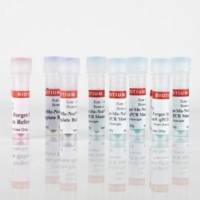Analysis and Reconstitution of Phycobiliproteins: Methods for the Characterization of Bilin Attachment Reactions
互联网
682
Phycobiliproteins are a homologous family of light-harvesting accessory proteins present in cyanobacteria (25 ,51 ), red algae (25 ), cryptomonads (36 ,52 ), and some species of prochlorophytes (41 ,48 ). The blue, violet, red, or yellow colors of the phycobiliproteins are due to linear tetrapyrrole chromophores called bilins that are covalently attached at cysteine residues (25 ). These water-soluble proteins are composed of α and β subunits. The αβ monomers form (αβ)3 trimers which further stack into (αβ)6 hexamers. These discshaped trimers and hexamers can be stabilized or organized into larger structures by linker proteins. Through the association of several types of phycobiliproteins with these linker proteins [69 ), the large light-harvesting complex called the phycobili-some is formed (51 ,63 ). Cryptomonad phycobiliproteins have a different composition and structural organization and will not be discussed further in this chapter (for reviews on cryptomonad phycobiliproteins, see References 36 , 52 , 53 , and 73 ).









